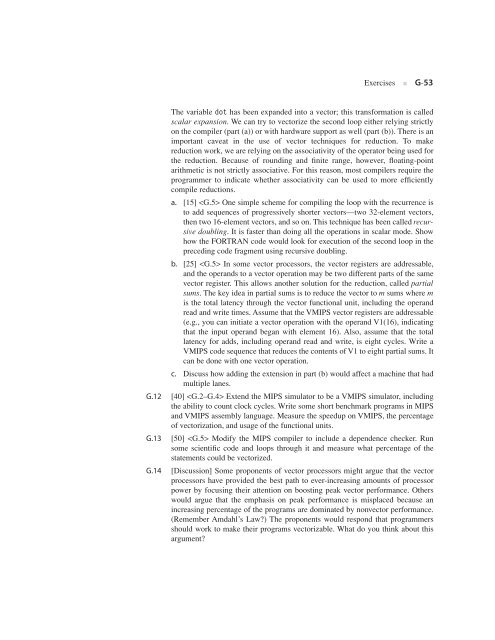Appendix G - Clemson University
Appendix G - Clemson University
Appendix G - Clemson University
You also want an ePaper? Increase the reach of your titles
YUMPU automatically turns print PDFs into web optimized ePapers that Google loves.
Exercises ■ G-53<br />
The variable dot has been expanded into a vector; this transformation is called<br />
scalar expansion. We can try to vectorize the second loop either relying strictly<br />
on the compiler (part (a)) or with hardware support as well (part (b)). There is an<br />
important caveat in the use of vector techniques for reduction. To make<br />
reduction work, we are relying on the associativity of the operator being used for<br />
the reduction. Because of rounding and finite range, however, floating-point<br />
arithmetic is not strictly associative. For this reason, most compilers require the<br />
programmer to indicate whether associativity can be used to more efficiently<br />
compile reductions.<br />
a. [15] One simple scheme for compiling the loop with the recurrence is<br />
to add sequences of progressively shorter vectors—two 32-element vectors,<br />
then two 16-element vectors, and so on. This technique has been called recursive<br />
doubling. It is faster than doing all the operations in scalar mode. Show<br />
how the FORTRAN code would look for execution of the second loop in the<br />
preceding code fragment using recursive doubling.<br />
b. [25] In some vector processors, the vector registers are addressable,<br />
and the operands to a vector operation may be two different parts of the same<br />
vector register. This allows another solution for the reduction, called partial<br />
sums. The key idea in partial sums is to reduce the vector to m sums where m<br />
is the total latency through the vector functional unit, including the operand<br />
read and write times. Assume that the VMIPS vector registers are addressable<br />
(e.g., you can initiate a vector operation with the operand V1(16), indicating<br />
that the input operand began with element 16). Also, assume that the total<br />
latency for adds, including operand read and write, is eight cycles. Write a<br />
VMIPS code sequence that reduces the contents of V1 to eight partial sums. It<br />
can be done with one vector operation.<br />
c. Discuss how adding the extension in part (b) would affect a machine that had<br />
multiple lanes.<br />
G.12 [40] Extend the MIPS simulator to be a VMIPS simulator, including<br />
the ability to count clock cycles. Write some short benchmark programs in MIPS<br />
and VMIPS assembly language. Measure the speedup on VMIPS, the percentage<br />
of vectorization, and usage of the functional units.<br />
G.13 [50] Modify the MIPS compiler to include a dependence checker. Run<br />
some scientific code and loops through it and measure what percentage of the<br />
statements could be vectorized.<br />
G.14 [Discussion] Some proponents of vector processors might argue that the vector<br />
processors have provided the best path to ever-increasing amounts of processor<br />
power by focusing their attention on boosting peak vector performance. Others<br />
would argue that the emphasis on peak performance is misplaced because an<br />
increasing percentage of the programs are dominated by nonvector performance.<br />
(Remember Amdahl’s Law?) The proponents would respond that programmers<br />
should work to make their programs vectorizable. What do you think about this<br />
argument?

















